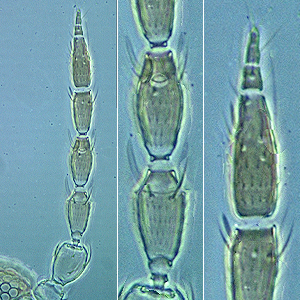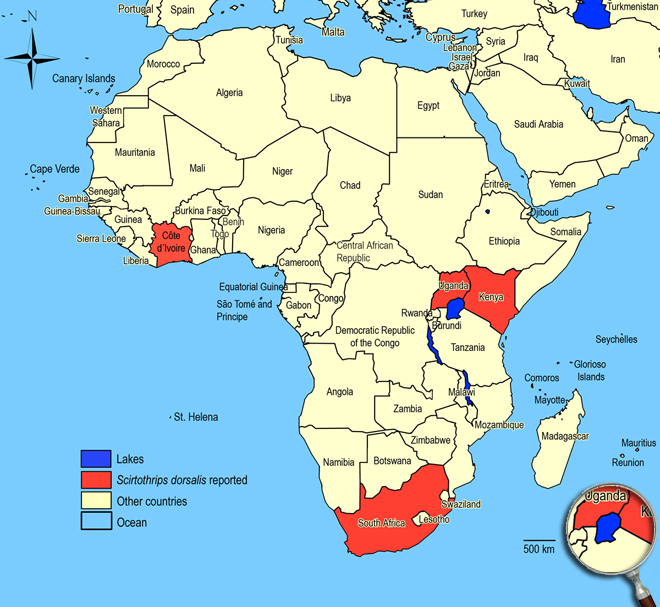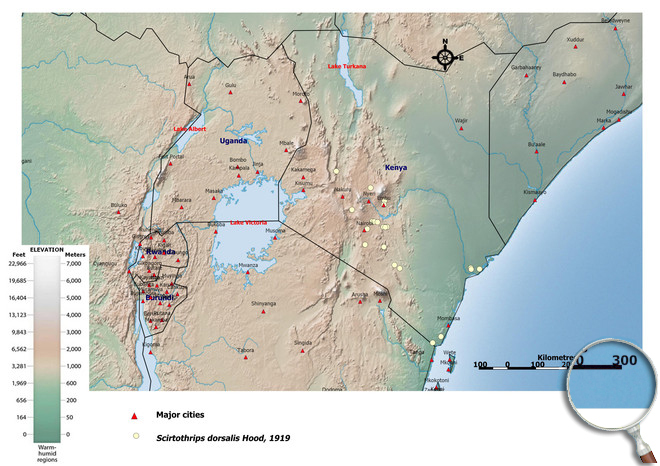Amin PW & Palmer JM (1985). Identification of groundnut Thysanoptera. Tropical Pest Management. 31 (4): 286-291
Amin PW, Reddy DVR, Ghanekar AM & Reddy MS (1981). Transmission of Tomato Spotted Wilt Virus, the causal agent of bud necrosis of peanut, by Scirtothrips dorsalis and Frankliniella schultzei. Plant Disease. 65 (8): 663-665
Ananthakrishnan TN (1971). Thrips (Thysanoptera) in agriculture, horticulture & forestry - diagnosis, bionomics & control. Journal of Scientific and Industrial Research. 30 (3): 113-146
Ananthakrishnan TN (1984). Bioecology of thrips. Indira Publishing House, Oak Park, Michigan, 223 pp
Arthurs S, McKenzie CL, Chen J, Dogramaci M, Brennan M, Houben K & Osborne L (2009). Evaluation of Neoseiulus cucumeris and Amblyseius swirskii (Acari: Phytoseiidae) as biological control agents of chilli thrips, Scirtothrips dorsalis (Thysanoptera: Thripidae) on pepper. Biological Control 49: 91-96
Bagnall RS (1919). Brief descriptions of new Thysanoptera X. Annals and Magazine of Natural History, Zoology, Botany and Geology. (Serie 9) 4: 253-277
Bailey SF (1964). A revision of the genus Scirtothrips Shull (Thysanoptera: Thripidae). Hilgardia. 35 (13): 329-362
Bournier J-P (1999). Two Thysanoptera, new cotton pests in Cote ďIvoire. Annales de la Société Entomologique de France. 35 (3-4): 275-281
Cabrera-Asencio I & Ramirez A (2007). Scirtothrips dorsalis Hood (Thysanoptera: Thripidae) a new record for Puerto Rico. Journal of Agriculture of the University of Puerto Rico. 91 (1-2): 49-52
Chu C-C, Ciomperlik MA, Chang N-T, Richards M & Henneberry TJ (2006). Developing and evaluating traps for monitoring Scirtothrips dorsalis (Thysanoptera: Thripidae). Florida Entomologist. 89 (1): 47-55
Dogramaci M, Arthurs SP, Chen J, McKenzie CL, Irrizary F, Osborne L (2011). Management of chilli thrips Scirtothrips dorsalis (Thysanoptera: Thripidae) on peppers by Amblyseius swirskii (Acari: Phytoseiidae) and Orius indidiosus (Hemiptera: Anthocoridae). Biological Control. 59: 340-347
Gilbert MJ (1986). First African record of Scirtothrips dorsalis Hood (Thysanoptera, Thripidae) a potential pest of citrus and other crops in southern-Africa. Journal of the Entomological Society of Southern Africa. 49 (1): 159-161
Girault AA (1927). Some new wild animals from Queensland. Published privately, Brisbane, 3 pp
Hoddle MS, Heraty JM, Rugman-Jones PF, Mound LA & Stouthamer R (2008). Relationships among species of Scirtothrips (Thysanoptera: Thripidae, Thripinae) using molecular and morphological data. Annals of the Entomological Society of America. 101 (3): 491-500
Hoddle MS & Mound LA (2003). The genus Scirtothrips in Australia (Insecta, Thysanoptera, Thripidae). Zootaxa. 268: 1-40
Hood JD (1919). On some Thysanoptera from Southern India. Insecutor Inscitiae Menstruus. 7: 90-103
Jagdish EJ & Purnima AP (2011). Evaluation of selective botanicals and entomopathogens against Scirtothrips dorsalis Hood under polyhouse conditions on rose. Journal of Biopesticides. 4: 81 - 85
Johansen RM & Mojica-Guzmán A (1998). The genus Scirtothrips Shull, 1909 (Thysanoptera: Thripidae, Sericothripini), in Mexico. Folia Entomologica Mexicana. 104: 23-108
Kannan M, Uthamasamy S & Mohan S (2004). Impact of insecticides on sucking pests and natural enemy complex of transgenic cotton. Current Science. 86 (5): 726-729
Karny H (1925). Die an Tabak auf Java und Sumatra angetroffenen Blasenfüsser. Bulletin van het deli Proefstation te Medan. 23: 1-55
Kumar NKK, Aradya M, Deshpande AA, Anand N & Ramachandar PR (1996). Initial screening of chili and sweet pepper germplasm for resistance to chili thrips, Scirtothrips dorsalis Hood. Euphytica. 89 (3): 319-324
Kuriyama K, Shinkaji N & Amano H (1991). Ecological studies on the yellow tea thrips, Scirtothrips dorsalis Hood (Thysanoptera, Thripidae) on potted Hydrangea in the greenhouse. 1. Route of invasion into the greenhouse and seasonal population dynamics. Japanese Journal of Applied Entomology and Zoology. 35 (1): 23-29
Masui S (2007). Timing and distance of dispersal by flight of adult yellow tea thrips, Scirtothrips dorsalis Hood (Thysanoptera: Thripidae). Japanese Journal of Applied Entomology and Zoology. 51 (2): 137-140
Masui S (2007). Oviposition time of overwintered adults of yellow tea thrips, Scirtothrips dorsalis Hood (Thysanoptera: Thripidae). Japanese Journal of Applied Entomology and Zoology. 51 (4): 289-291
Masui S (2007). Synchronism of immigration of adult yellow tea thrips, Scirtothrips dorsalis Hood (Thysanoptera: Thripidae) to citrus orchards with reference to their occurrence on surrounding host plants. Applied Entomology and Zoology. 42 (4): 517-523
Masumoto M & Okajima S (2007). The genus Scirtothrips Shull (Insecta, Thysanoptera, Thripidae) and three related genera in Japan. Zootaxa. (1552): 1-33
Mikunthan G & Manjunatha M (2008). Impact of habitat manipulation on mycopathogen, Fusarium semitectum to control Scirtothrips dorsalis and Polyphagotarsonemus latus of chilli. BioControl. 53 (2): 403-412
Moritz G (2006). Thripse. Pflanzensaftsaugende Insekten, Bd. 1, (1. Auflage). Westarp, Hohenwarsleben, 384 pp. ISBN-13: 978 3 89432 891 7
Moritz G, Delker C, Paulsen M, Mound LA, Burgermeister W (2000). Modern methods in thrips-identification and information (Insecta, Thysanoptera). Bulletin OEPP/EPPO (Paris) 30: 591-593
Moritz G, Morris DC & Mound LA (2001). ThripsID - Pest thrips of the world. ACIAR and CSIRO Publishing Collingwood, Victoria, Australia, CDROM ISBN 1 86320 296 X
Moritz G, Mound LA, Morris DC & Goldarazena A (2004). Pest thrips of the world - an identification and information system using molecular and microscopical methods. Centre for Biological Information Technology, University of Queensland, Australia, CDROM ISBN 1 86499 781 8
Moritz G, O'Donnell C & Parrella M (2009). Pest thrips of North America. Centre for Biological Information Technology, University of Queensland, Australia, CDROM ISBN-13: 978 1 86499 940 2
Mound LA (1968). A review of R. S. Bagnalľs Thysanoptera collections. Bulletin of the British Museum (Natural History), Entomology. Supplement 11: 1-181
Mound LA (1968). A new species of Scirtothrips from Kenya attacking tea, with synonymic notes on two related pest species. Bulletin of Entomological Research. 57 (4): 533-538
Mound LA & Kibby G (1998). Thysanoptera: An identification guide, (2nd edition). CAB International, Wallingford and New York, 70 pp
Mound LA & Marullo R (1996). The thrips of Central and South America: An introduction (Insecta: Thysanoptera). Memoirs on Entomology, International, Vol. 6. Associated Publishers, Gainsville, 487 pp
Mound LA & Palmer JM (1981). Identification, distribution and host-plants of the pest species of Scirtothrips (Thysanoptera: Thripidae). Bulletin of Entomological Research. 71: 467-479
Mound LA & zur Strassen R (2001). The genus Scirtothrips (Thysanoptera: Thripidae) in Mexico: a critique of the review by Johansen & Mojica-Guzmán (1998). Folia Entomologica Mexicana. 40: 133-142
Nair VV, Reghunath P & Visalakshi A (1991). Control of the Thrips Scirtothrips dorsalis Hood on rose. Entomon. 16 (4): 327-329
Nietschke BS, Borchert DM, Magarey RD & Ciomperlik MA (2008). Climatological potential for Scirtothrips dorsalis (Thysanoptera: Thripidae) establishment in the United States. Florida Entomologist. 91 (1): 79-86
OEPP/EPPO (2005). Scirtothrips aurantii, Scirtothrips citri, Scirtothrips dorsalis. Bulletin OEPP/EPPO Bulletin. 35: 353-356
Okada T (1981). Searching behavior for pupation place by late 2nd instar larvae of Scirtothrips dorsalis Hood (Thysanoptera, Thripidae). Japanese Journal of Applied Entomology and Zoology. 25 (1): 10-16
Okada T & Kudo I (1982). Overwintering sites and stages of Scirtothrips dorsalis Hood (Thysanoptera, Thripidae) in tea fields. Japanese Journal of Applied Entomology and Zoology. 26 (3): 177-182
Palmer JM, Mound LA & du Heaume GJ (1989). 2. Thysanoptera, 73 pp. In Betts CR [ed.], CIE Guides to insects of importance to man. CAB International, Wallingford, Oxon, UK
Patel BH, Koshiya DJ, Korat DM & Vaishnav PR (2010). Effect of irrigation intervals and nitrogen levels on the incidence of thrips, Scirtothrips dorsalis Hood in chilli. Karnataka Journal of Agricultural Sciences. 23 (2): 243-245
Raizada U (1965). The life-history of Scirtothrips dorsalis Hood with detailed external morphology of its immature stages. Bulletin of Entomology. 6: 30-49
Ramakrishna TV (1942). Insects associated with the lotus plant. Indian Journal of Entomology. 4: 167-170
Rugman-Jones PF, Hoddle MS, Mound LA & Stouthamer R (2006). Molecular identification key for pest species of Scirtothrips (Thysanoptera: Thripidae). Journal of Economic Entomology. 99 (5): 1813-1819
Seal DR, Ciomperlik M, Richards ML & Klassen W (2006). Comparative effectiveness of chemical insecticides against the chilli thrips, Scirothrips dorsalis Hood (Thysanoptera: Thripidae), on pepper and their compatibility with natural enemies. Crop Protection. 25 (9): 949-955
Seal DR, Ciomperlik MA, Richards ML & Klassen W (2006). Distribution of chilli thrips, Scirtothrips dorsalis (Thysanoptera: Thripidae), in pepper fields and pepper plants on St. Vincent. Florida Entomologist. 89 (3): 311-320
Seal DR & Klassen W (2005). Chilli thrips (castor thrips, Assam thrips, yellow tea thrips, strawberry thrips), Scirtothrips dorsalis Hood, Provisional Management Giudelines. Entomology and Nematology Department, Florida Cooperative Extension Service, Institute of Food and Agricultural Sciences, University of Florida, ENY-725 (IN638), 4 pp http://edis.ifas.ufl.edu/in638
Seal DR, Kumar V, Klassen W, Sabine K (2008). Response of chilli thrips, Scirtothrips dorsalis, and melon thrips, Thrips palmi, to some selected insecticides. Proceedings of the Caribbean Food Crops Society 44: 578.
Shibao M (1996). Damage analysis of chillie thrips, Scirtothrips dorsalis Hood (Thysanoptera: Thripidae) on grape. Japanese Journal of Applied Entomology and Zoology. 40 (4): 293-297
Shibao M (1996). Effects of temperature on development of the chillie thrips, Scirtothrips dorsalis Hood (Thysanoptera: Thripidae), on grape. Applied Entomology and Zoology. 31 (1): 81-86
Shibao M (1996). Effects of a vinyl film cover on the population density of the chillie thrips, Scirtothrips dorsalis Hood (Thysanoptera: Thripidae), on grape. Applied Entomology and Zoology. 31 (1): 174-177
Shibao M (1997). Effects of resource availability on population density of the chillie thrips, Scirtothrips dorsalis Hood (Thysanoptera: Thripidae), on grape. Applied Entomology and Zoology. 32 (2): 413-415
Shibao M (1997). Effects of insecticide application on population density of the chillie thrips, Scirtothrips dorsalis Hood (Thysanoptera: Thripidae), on grape. Applied Entomology and Zoology. 32 (3): 512-514
Shibao M, Ehara S, Hosomi A & Tanaka H (2004). Seasonal fluctuation in population density of phytoseiid mites and the yellow tea thrips, Scirtothrips dorsalis Hood (Thysanoptera: Thripidae) on grape, and predation of the thrips by Euseius sojaensis (Ehara) (Acari: Phytoseiidae). Applied Entomology and Zoology. 39 (4): 727-730
Shibao M, Ehara S, Hosomi A & Tanaka H (2006). Effect of insecticide application on the population density of yellow tea thrips, Scirtothrips dorsalis Hood (Thysanoptera: Thripidae) and Euseius sojaensis (Ehara) (Acari: Phytoseiidae) on grapes. Japanese Journal of Applied Entomology and Zoology. 50 (3): 247-252
Shibao M, Hosomi A & Tanaka H (2000). Seasonal fluctuation in percentage parasitism of the yellow tea thrips, Scirtothrips dorsalis Hood (Thysanoptera: Thripidae) by an egg parasitoid of Megaphragma (Hymenoptera: Trichogrammatidae) on grapes. Entomological Science 3: 4, 611-613
Shibao M, Tanaka F, Fujisaki K & Nakasuji F (1993). Effects of lateral shoot cutting on population density of the chillie thrips, Scirtothrips dorsalis Hood (Thysanoptera, Thripidae) on grape. Applied Entomology and Zoology. 28 (1): 35-41
Shibao M, Tanaka F, Tsukuda R & Fujisaki K (1991). Overwintering sites and stages of the chillie thrips, Scirtothrips dorsalis Hood (Thysanoptera, Thripidae) in grape fields. Japanese Journal of Applied Entomology and Zoology. 35 (2): 161-163
Tatara A (1994). Effect of temperature and host-plant on the development, fertility and longevity of Scirtothrips dorsalis Hood (Thysanoptera, Thripidae). Applied Entomology and Zoology. 29 (1): 31-37
Tsuchiya M, Furuhashi K & Masui S (1995). Behavior of yellow tea thrips Scirtothrips dorsalis (Hood) on a reflective sheet. Japanese Journal of Applied Entomology and Zoology. 39 (4): 289-297
Tsuchiya M, Masui S & Kuboyama N (1995). Color attraction of yellow tea thrips (Scirtothrips dorsalis Hood). Japanese Journal of Applied Entomology and Zoology. 39 (4): 299-303
Umar M, Akram W, Ali B, Tariq M & Shah NA (2003). Description of three genera (Thripidae: Thysanoptera) from Azad Jammu and Kashmir (Pakistan). Online Journal of Biological Sciences. 3 (5): 524-534
Yadwad A, Sridevi O & Salimath PM (2008). Leaf trichomes-based resistance in chilli (Capsicum annuum) to thrips and mites. Indian Journal of Agricultural Sciences. 78 (6): 518-521
Yamaguchi T, Kiritani K, Matsuhira K & Fukuda K (2001). The influence of unusual hot weather on the occurrence of several arthropod crop pests. Japanese Journal of Applied Entomology and Zoology. 45 (1): 1-7












